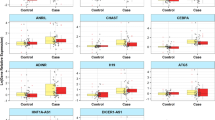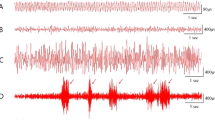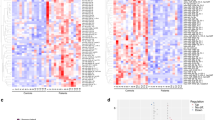Abstract
Calcium signaling is a metabolic pathway that is essential in neurons development and can be involved in the pathobiology of epilepsy. We assessed expression of three mRNA coding gene (SLC1A1, SLC25A12, and ATP2B2) and three related long non-coding RNAs (LINC01231:1, lnc-SLC25A12-8:1 and lnc-MTR-1:1) from this pathway in 39 patients with refractory epilepsy and 71 healthy controls. Expression of all genes except for lnc-SLC25A12 was higher in total epileptic cases compared with controls (P values = 0.0002, < 0.0001, < 0.0001, 0.049 and 0.0005 for SLC1A1, SLC25A12, LINC01231, ATP2B2 and lnc-MTR-1, respectively. When we separately compared expression of genes among males and females, SLC1A1, SLC25A12, LINC01231 and lnc-MTR-1 showed up-regulation in male cases compared with male controls. Moreover, expressions of SLC1A1 and SLC25A12 were higher in female cases compared with female controls. Remarkably, SLC25A12 was found to have the highest sensitivity value (= 1) for differentiation of epileptic cases from controls. Moreover, lnc-MTR-1 and lnc-SLC25A12 were sensitive markers for such purpose (sensitivity values = 0.89 and 0.87, respectively). The highest value belonged to LINC01231 with the value of 0.76. Taken together, this study demonstrates dysregulation of calcium-signaling related genes in epileptic patients and suggests these genes as potential biomarkers for epilepsy.
Similar content being viewed by others
Introduction
Brain tissue is involved in many neurological disorders and one of these chronic disorders is epilepsy. Epilepsy is defined as a condition that patient has long-lasting generating seizures1. One third of patients with epilepsy do not respond to anti-seizure drugs and are known to have refractory epilepsy2. This condition affects quality of life and has adverse results in daily routines3.
Calcium signaling is a metabolic pathway that is essential in neurons development. Calcium acts as an important second messenger and contributes to the correct synapse activities. So, it is obvious that distraction in this signaling pathway may result in neurodevelopmental disorders4. Intrinsic burst firing, mediated by inward calcium ion is considered as the initiator of epileptic activity5. Calcium signaling is regulated by long non-coding RNAs (lncRNAs). Several calcium-binding proteins are subjected to regulation by these transcripts6.
Several of proteins and non-coding RNAs are involved in calcium signaling. For instance, ATP2B2 gene codes a protein that removes bivalent calcium ions from cells and plays a critical role in calcium homeostasis. This gene is regulated by an lncRNA, namely lnc-MTR-17. Solute Carrier Family 1 Member 1 (SLC1A1) is a glutamate transporter that is related with a number of signaling pathways including Transport of inorganic cations/anions. Mutations in this gene might be involved in the pathogenesis of schizophrenia8. Most notably, rare variants in this gene have been found to be associated with a kind of sensory epilepsy9.
SLC25A12 codes for a mitochondrial aspartate/glutamate transporter which is principally expressed in neurons10. This protein is involved in the exchange of aspartate for glutamate and protons in the mitochondria11. Dysfunction of this protein leads to defects in the transport of aspartate into the cytoplasm, reduction of N-acetyl glutamate production in the cytoplasm and subsequent defects in the production of myelin11. SLC25A12 variants are involved in the pathogenesis of epilepsy12,13 possibly due to accumulation of glutamate which results in cellular injury14.
The role of calcium signaling related genes has been discussed in the context of brain disorders such as autism spectrum disorder15. Since calcium signaling has an efficient role in the neurodevelopmental disorders through regulation of normal neuronal activity, the related genes may play a role in the epilepsy as well. Thus, we analyzed expression of SLC1A1, SLC25A12, and ATP2B2 genes that encode calcium signaling proteins that play a part in storing, regulation, and transmission of calcium in neurons. We also assessed expression of three lncRNAs that are related with these genes, namely LINC01231:1, lnc-SLC25A12-8:1 and lnc-MTR-1:1T, respectively, as predicted by the LNCipedia16 and RNAcentral17 databases. The regulatory network constructed by lncRNA-mRNA interactions may affect epileptogenesis and can be considered as a putative target for therapeutic interventions, particularly in refractory epilepsy.
Methods
Patients and controls
In total, 40 patients with refractory seizures and 71 healthy persons (41 males and 30 females) were enrolled in the current study. Patients were classified according to the definition of International League Against Epilepsy (ILAE), “failure of adequate trials of two tolerated, properly selected and used antiepileptic drug plans (whether as monotherapy or in combination) to accomplish continued seizure freedom”18. Diagnosis was based on electroencephalogram and brain magnetic resonance imaging. Informed consent forms were signed by all participants. The study protocol was permitted by ethical committee of Shahid Beheshti University of Medical Sciences.
Experiments
In this assay, we measured expression of six genes (coding and non-coding) which are shown in Table 1. For this purpose, we took blood samples from 39 refractory epileptic patients (5 cc of whole blood). Total RNA extraction and cDNA synthesis were accomplished by using RiboEx and SMOBIO kits, respectively. Then, real time PCR was performed in the ABI system using specific designed primers.
Statistical analysis
Statistical analysis was accomplished in GraphPad Prism version 9.0 (GraphPad Software, La Jolla, CA, USA). Expression levels of three genes encoding ion channels and transporters, namely SLC1A1, SLC25A12, ATP2B2 and their related lncRNAs, namely LINC01231, lnc-SLC25A12, and lnc-MTR-1 were measured in the peripheral blood obtained from 39 patients with refractory epilepsy and 71 healthy controls. Expression levels were assessed using the comparative − delta Ct method. The normal/gaussian distribution of the values was evaluated using the Shapiro–Wilk test. Unpaired t test or non-parametric test (Mann–Whitney U test) was used to identify differentially expressed genes between two groups. Effects of main factors on gene expression were determined using the two-way ANOVA and Tukey post hoc tests. Correlations between expression levels of genes were measured using the Spearman’s rank correlation coefficient.
Ethics approval and consent to participant
All procedures performed in studies involving human participants were in accordance with the ethical standards of the institutional and/or national research committee and with the 1964 Helsinki declaration and its later amendments or comparable ethical standards. Informed consent forms were obtained from all study participants. The study protocol was approved by the ethical committee of Shahid Beheshti University of Medical Sciences. All methods were performed in accordance with the relevant guidelines and regulations.
Results
General data
The study included 39 patients with refractory epilepsy (16 male subjects and 23 female subjects). Moreover, we included 71 healthy persons as controls (41 male subjects and 30 female subjects).
Expression assays
Expression levels of SLC1A1, SLC25A12, ATP2B2 and their related lncRNAs were significantly different between patients with epilepsy and healthy subjects (Fig. 1).
Expression of three genes encoding ion channels and transporters including SLC1A1, SLC25A12, ATP2B2 and their related long non-coding RNAs, namely LINC01231, lnc-SLC25A12, and lnc-MTR-1 in epilepsy patients and healthy controls as described by − delta Ct values. Following the normality test, unpaired t test (for SLC25A12 and lnc-SLC25A12) and non-parametric test (Mann–Whitney U test) (for SLC1A1, ATP2B2, LINC01231 and lnc-MTR-1) was used to identify differentially expressed genes between two groups (* < 0.05, ***P value < 0.001 and ****P value < 0.0001).
Group factor (disease) had a significant effect on expression levels of SLC1A1, SLC25A12, LINC01231 and lnc-MTR-1. On the other hand, gender factor and interaction between gender and group had no effect on expression levels of any of genes (Table 2); so, we did not perform post hoc tests for multiple comparisons.
Expression of all genes except for lnc-SLC25A12 was higher in total epileptic cases compared with controls (P values = 0.0002, < 0.0001, < 0.0001, 0.049 and 0.0005 for SLC1A1, SLC25A12, LINC01231, ATP2B2 and lnc-MTR-1, respectively (Table 3). When we separately compared expression of genes among males and females, SLC1A1, SLC25A12, LINC01231 and lnc-MTR-1 showed up-regulation in male cases compared with male controls. Moreover, expressions of SLC1A1 and SLC25A12 were higher in female cases compared with female controls.
Since most of Ct values were not normally distributed, we used non parametric Spearman’s correlations between RNA expression levels among the epileptic patients and healthy controls. When analyzing the correlation between expression levels of genes, we noticed that the most robust correlations were between lnc-MTR-1/ATP2B2, ATP2B2/lnc-SLC25A12 and lnc-MTR-1/lnc-SLC25A12 pairs among epileptic cases with correlation coefficients of 0.73, 0.73 and 0.68, respectively (Table 4).
AUC values for mentioned genes ranged from 0.78 for SLC1A1 and LINC01231 to 0.59 for lnc-SLC25A12 (Fig. 2).
Remarkably, SLC25A12 was found to have the highest sensitivity value (= 1) for differentiation of epileptic cases from controls. Moreover, lnc-MTR-1 and lnc-SLC25A12 were sensitive markers for such purpose (sensitivity values = 0.89 and 0.87, respectively). The highest value belonged to LINC01231 with the value of 0.76 (Table 5).
Discussion
Calcium signaling has an important role in the neurological disorders. In fact, the triad of excitotoxicity, calcium and mitochondria has been found to be involved in synaptic neurodegeneration19. Malfunction of proteins related with this pathway is followed by mitochondrial calcium toxicity and excitotoxic dendritic loss and hence neurodegeneration19. Meanwhile, neurons channel proteins and synaptic plasticity are two targets of lncRNAs which are intertwined with epilepsy pathogenesis20.
It is also confirmed that astrocytes have a key role in controlling the conformation of the extracellular fluids, and can directly cooperate with neurons by discharging gliotransmitters. Notably, astrocytic intracellular Calcium signals increase discharge of signaling elements, either via synaptic or non-synaptic routes. Thus, astrocytic calcium signals have crucial roles in epileptogenesis21. Calbindin-D28K, a member of calcium binding protein family has been found to be down-regulated in the cortical tubers of patients with tuberous sclerosis complex associated with refractory epilepsy22. However, expression of other calcium-related proteins has not been assessed in refractory versus non-refractory epilepsy.
In the current study, we measured expression of a number of mRNA coding genes and lncRNAs in epileptic patients. Expression of all genes except for lnc-SLC25A12 was higher in total epileptic cases compared with controls. When we separately compared expression of genes among males and females, SLC1A1, SLC25A12, LINC01231 and lnc-MTR-1 showed up-regulation in male cases compared with male controls. Moreover, expressions of SLC1A1 and SLC25A12 were higher in female cases compared with female controls. A previous study has reported significant elevation of SLC1A1 expression in dentate granule cells from rats with spontaneous seizure compared with similar cells from control rats23. Moreover, expression of these transcripts have been shown to be high in human dentate granule cells from patients with temporal lobe epilepsy and as well as in dysplastic neurons in cortical dysplasia compared with non-dysplastic neurons of control tissues obtained from autopsy23. Thus, the results of our study provide further evidence for involvement of SLC1A1 in the pathobiology of epilepsy. We also detected up-regulation of LINC01231, the lncRNA that interacts with the SLC1A1 mRNA. This lncRNA has also been shown to be upregulated in major depressive disorder cases and down-regulated in Alzheimer’s disease patients24. Thus, it is involved in a variety of neurologic disorders.
In line with our findings, mutations in SLC25A12 gene are associated with infantile epileptic encephalopathy, psychomotor retardation, hypomyelination of the CNS and seizures25. Moreover, two polymorphisms within SLC25A12 gene (rs2292813 and rs2056202) are associated with autism spectrum disorder26. In spite of up-regulation of this gene in epileptic cases, expression of the related lncRNA with this gene (lnc-SLC25A12) was not different between cases and controls. This finding might suggest that the role of this mRNA coding gene in epilepsy is independent from the related lncRNA.
We also noticed that the most robust correlations were between lnc-MTR-1/ATP2B2, ATP2B2/lnc-SLC25A12 and lnc-MTR-1/lnc-SLC25A12 pairs among epileptic cases. In fact, the strongest correlation was detected between ATP2B2 and its related lncRNA, i.e. lnc-MTR-1. However, the correlations between other mRNA coding genes and their related lncRNAs were not so strong.
Remarkably, SLC25A12, lnc-MTR-1 and lnc-SLC25A12 were found to be sensitive markers for differentiation of epileptic cases from controls. However, the specificity of these transcripts were not appropriate. Taken together, this study demonstrates dysregulation of calcium-signaling related genes in epileptic patients and suggests these genes as potential biomarkers for epilepsy.
Data availability
All data generated or analysed during this study are included in this published article (and its Supplementary Information files).
References
Beghi, E. The epidemiology of epilepsy. Neuroepidemiology 54, 185–191 (2020).
Janson, M. T. & Bainbridge, J. L. Continuing burden of refractory epilepsy. Ann. Pharmacother. 55, 406–408. https://doi.org/10.1177/1060028020948056 (2020).
World Health Organization. Epilepsy: A Public Health Imperative (2019).
Zamponi, G. W., Lory, P. & Perez-Reyes, E. Role of voltage-gated calcium channels in epilepsy. Pflügers Arch.-Eur. J. Physiol. 460, 395–403 (2010).
Kułak, W., Sobaniec, W., Wojtal, K. & Czuczwar, S. J. Calcium modulation in epilepsy. Pol. J. Pharmacol. 56, 29–41 (2004).
Ghafouri-Fard, S. et al. The interaction between non-coding RNAs and calcium binding proteins. Front. Oncol. 12, 848376. https://doi.org/10.3389/fonc.2022.848376 (2022).
Smits, J. J. et al. De novo and inherited loss-of-function variants of ATP2B2 are associated with rapidly progressive hearing impairment. Hum. Genet. 138, 61–72 (2019).
Afshari, P. et al. Characterization of a novel mutation in SLC1A1 associated with schizophrenia. Mol. Neuropsychiatry 1, 125–144 (2015).
Karan, K. R., Satishchandra, P., Sinha, S. & Anand, A. Rare SLC1A1 variants in hot water epilepsy. Hum. Genet. 136, 693–703. https://doi.org/10.1007/s00439-017-1778-7 (2017).
Sanz, R., del Arco, A., Ayuso, C., Ramos, C. & Satrústegui, J. Assignment of the calcium-binding mitochondrial carrier Aralar1 gene (SLC25A12) to human chromosome band 2q31 by in situ hybridization. Cytogenet. Cell Genet. 89, 143–144 (2000).
Jalil, M. A. et al. Reduced N-acetylaspartate levels in mice lacking aralar, a brain-and muscle-type mitochondrial aspartate-glutamate carrier. J. Biol. Chem. 280, 31333–31339 (2005).
Wibom, R. et al. AGC1 deficiency associated with global cerebral hypomyelination. N. Engl. J. Med. 361, 489–495 (2009).
Falk, M. J. et al. AGC1 deficiency causes infantile epilepsy, abnormal myelination, and reduced N-acetylaspartate. JIMD Rep. 14, 77–85 (2014).
Gan, Y. et al. Solute carrier transporter disease and developmental and epileptic encephalopathy. Front. Neurol. 13, 1013903 (2022).
Ghafouri-Fard, S., Pourtavakoli, A., Hussen, B. M., Taheri, M. & Ayatollahi, S. A. A review on the role of genetic mutations in the autism spectrum disorder. Mol. Neurobiol. 60, 1–17 (2023).
Volders, P. J. et al. LNCipedia: A database for annotated human lncRNA transcript sequences and structures. Nucleic Acids Res. 41, D246-251. https://doi.org/10.1093/nar/gks915 (2013).
Sweeney, B. A. et al. RNAcentral 2021: Secondary structure integration, improved sequence search and new member databases. Nucleic Acids Res. 49, D212–D220. https://doi.org/10.1093/nar/gkaa921 (2021).
Kwan, P. et al. (Wiley Online Library, 2010).
Verma, M., Lizama, B. N. & Chu, C. T. Excitotoxicity, calcium and mitochondria: A triad in synaptic neurodegeneration. Transl. Neurodegener. 11, 3. https://doi.org/10.1186/s40035-021-00278-7 (2022).
Lipovich, L. et al. Activity-dependent human brain coding/noncoding gene regulatory networks. Genetics 192, 1133–1148 (2012).
Heuser, K. & Enger, R. Astrocytic Ca(2+) signaling in epilepsy. Front. Cell Neurosci. 15, 695380. https://doi.org/10.3389/fncel.2021.695380 (2021).
Valencia, I. et al. Anomalous inhibitory circuits in cortical tubers of human tuberous sclerosis complex associated with refractory epilepsy: Aberrant expression of parvalbumin and calbindin-D28k in dysplastic cortex. J. Child Neurol. 21, 1058–1063 (2006).
Crino, P. B. et al. Increased expression of the neuronal glutamate transporter (EAAT3/EAAC1) in hippocampal and neocortical epilepsy. Epilepsia 43, 211–218. https://doi.org/10.1046/j.1528-1157.2002.35001.x (2002).
Ruihan, W., Jinghao, D., Zheng, Q. & Xueping, C. Gene Expression Meta-Analysis of Major Depressive Disorder and Its Relationship with Alzheimer’s Disease (2021).
Ghaoui, R. & Sue, C. M. Movement disorders in mitochondrial disease. J. Neurol. 265, 1230–1240 (2018).
Aoki, Y. & Cortese, S. Mitochondrial aspartate/glutamate carrier SLC25A12 and autism spectrum disorder: A meta-analysis. Mol. Neurobiol. 53, 1579–1588 (2016).
Acknowledgements
The authors would like to thank the clinical Research Development Unit (CRDU) of Loghman Hakim Hospital, Shahid Beheshti University of Medical Sciences, Tehran, Iran for their support, cooperation and assistance throughout the period of study.
Author information
Authors and Affiliations
Contributions
S.G.F. wrote the manuscript and revised it. M.T. and A.S. designed and supervised the study. M.T., A.S. and A.P. collected the data and performed the experiment. S.E. analyzed the data. All authors read and approved the submitted manuscript.
Corresponding authors
Ethics declarations
Competing interests
The authors declare no competing interests.
Additional information
Publisher's note
Springer Nature remains neutral with regard to jurisdictional claims in published maps and institutional affiliations.
Supplementary Information
Rights and permissions
Open Access This article is licensed under a Creative Commons Attribution 4.0 International License, which permits use, sharing, adaptation, distribution and reproduction in any medium or format, as long as you give appropriate credit to the original author(s) and the source, provide a link to the Creative Commons licence, and indicate if changes were made. The images or other third party material in this article are included in the article's Creative Commons licence, unless indicated otherwise in a credit line to the material. If material is not included in the article's Creative Commons licence and your intended use is not permitted by statutory regulation or exceeds the permitted use, you will need to obtain permission directly from the copyright holder. To view a copy of this licence, visit http://creativecommons.org/licenses/by/4.0/.
About this article
Cite this article
Taheri, M., Pourtavakoli, A., Eslami, S. et al. Assessment of expression of calcium signaling related lncRNAs in epilepsy. Sci Rep 13, 17993 (2023). https://doi.org/10.1038/s41598-023-45341-7
Received:
Accepted:
Published:
DOI: https://doi.org/10.1038/s41598-023-45341-7
This article is cited by
-
Expression assay of calcium signaling related lncRNAs in autism
Molecular Biology Reports (2024)
Comments
By submitting a comment you agree to abide by our Terms and Community Guidelines. If you find something abusive or that does not comply with our terms or guidelines please flag it as inappropriate.





